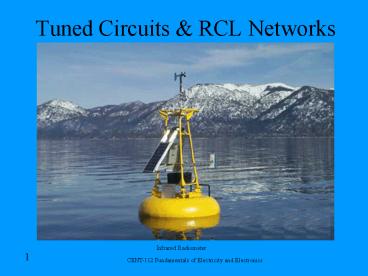Tuned Circuits - PowerPoint PPT Presentation
1 / 21
Title:
Tuned Circuits
Description:
Infrared Radiometer. CENT-112 Fundamentals of Electricity and Electronics. 2. Interest ... A. MRI machines, infrared radiometer, transistor radios & others. ... – PowerPoint PPT presentation
Number of Views:1467
Avg rating:3.0/5.0
Title: Tuned Circuits
1
Tuned Circuits RCL Networks
Infrared Radiometer
2
Interest
- Magnetic Resonance Imaging (MRI) Looks at the
body based on principles of magnetism and radio
wave transmission.
3
Outline
- Resonance
- Tank Circuit
- Series RCL Circuit
- Parallel RCL Circuit
- Amplifiers
- Filters
4
Tuned Circuits
- Series Tuned Circuits
- . Theory
- . Ideal Series resonant circuit contains no
resistance. It contains only inductance and
capacitance that are in series with each other
and with the source voltage. - . Operation
- . At Resonance ( XL XC ) therefore, XL XC
0. The resultant reactance is equal to 0.
Impedance ( Z ) is minimum. - . Since Z is minimum, current is maximum for a
given voltage. Maximum current flow causes
maximum voltage drops across individual
reactances.
5
Formulas
- XL 2 II f L.
- XC 1 / 2 II f C.
- Z XL XC R
- At resonance XL XC so 2 II f L 1 / 2 II f C,
therefore Fr .159/ LC
6
Questions
- Q. What is the formula for XL?
- A. XL 2 II f L.
- Q. What is the formula for XC?
- A. XC 1 / 2 II f C.
- Q. What is the resonant frequency in a typical
tuned circuit? - A. XL XC, Fr .159/Square root LC.
7
Tuned Circuit Operation
- . Operation (Continued)
- . When Frequency is lt Resonance
- XC ? gt current is lower gt voltage drops across
reactances are lower. - . When Frequency is gt Resonance
- XL ? gt current is lower gt voltage drops across
reactances are lower.
8
Series Tuned Circuit Schematic
9
Tuned Circuit Operation
- . Series Tuned Circuit Analysis
XL
o
R Z
0o
XC
XL
RESONANCE
XL
XL - XC
o
Capacitive
o
Inductive
Resistive
CURRENT
IMPEDANCE
XC - XL
XC
XC
ABOVE RESONANCE
BELOW RESONANCE
100
200
300
500
600
700
Fr
Z R
10
Parallel Tuned Circuits
- 1. Theory
- . Called a tank circuit because it can store
energy. - . It has the ability to take the energy fed to it
from a power source and store this energy
alternately in the inductor and capacitor. - . The resulting output is a continuous ac sine
wave. - . Operation
- . Voltage is the same across the inductor and
capacitor. (parallel) - . Current through the components varies inversely
with their reactances. - . Total current through the circuit is the
vectoral sum of the two individual component
currents. - . IL and IC are 180o out of phase.
- . At resonance, IL and IC cancel each other out
gt no current from source.
11
Parallel Tuned Circuits Continued
- . Application
- . At resonance, the circuit has a maximum
impedance which results in minimum current drawn
from the source.
12
Parallel Tuned Circuit Schematic
13
Parallel Tuned Circuits
IL
- . Circuit analysis
o
IC
IC
RESONANCE
IC
I
IC - IL
o
o
Capacitive
Resistive
Inductive
CURRENT
IMPEDANCE
IL - IC
IL
IL
Z
ABOVE RESONANCE
BELOW RESONANCE
100
200
300
500
600
700
Fr
14
Parallel Tuned Circuits
- . Applications
- . Tuned Amplifier
VCC
RB
IMAX
L1
C1
0
VIN
0
RL
CC
T
15
Questions
- Q. What are some examples of a parallel tuned
amplifiers? - A. Antenna tuners, air signal tracker, ham radio,
transponders (ID aircraft etc). - Q. What crystal can replace the RLC circuit to
make it last longer? - A. Piezoelectric Crystal.
16
Pulsed Amplifier
- . Pulsed Amplifier 3 main sections
- 1. Gain Amp 2. Input Gate Signal 3. Tank Circuit
VCC
R1
C1
0
VIN
OUTPUT SIGNAL
L1
C2
17
Pulsed Amplifier
T0
T1
T2
T3
INPUT GATE
OUTPUT SIGNAL
18
Tuned Amplifier
- c. Tuned Amplifier 3 main sections
- 1. Gain Amp 2. Positive Feedback Circuit 3.
Frequency Determining Device
VCC
R1
C1
0
VIN
OUTPUT SIGNAL
L1
Cy1
19
Overdriven Amplifier
SATURATION
CUTOFF
C1
C2
Q1
R2
R1
OUTPUT
INPUT
VCC
-VEE
SATURATION
CUTOFF
20
Overdriven Amplifier
- . The input signal drives the transistor into and
out of saturation and cutoff. - . When the transistor is in saturation and / or
cutoff, that portion of the input waveform is
clipped and the output is distorted.
21
Conclusions
- Q. What is the difference between series and
parallel resonant circuits? - A. The characteristics for current impedance,
and capacitance inductance are reversed. - Q. What are some examples of circuits that use
resonant circuits? - A. MRI machines, infrared radiometer, transistor
radios others.

